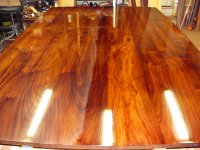I currently use dowels and really have no issue expect speed is a bit slow. The main issue I have is securing the dowel jig so it does not move around while drilling hard woods. There are some inaccuracies that can multiply on pieces with multiple joints.
When using the Domino is the movement? Does it effect the joint? I guess the hardest joint would be building say a table top and having misalignment of face edge to edge. I don't have planer or sander to do larger tops to correct surface misalignment. Yes a plane can do it but want a more accurate start then the Jessem jig I am using now.
Thanks
When using the Domino is the movement? Does it effect the joint? I guess the hardest joint would be building say a table top and having misalignment of face edge to edge. I don't have planer or sander to do larger tops to correct surface misalignment. Yes a plane can do it but want a more accurate start then the Jessem jig I am using now.
Thanks

